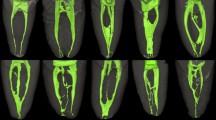Abstract
Purpose
An understanding of root anatomy is an important foundation for providing successful endodontic treatment. The aim of this study was to use micro-computed tomography (micro-CT) to investigate the root anatomy of the mandibular second molar.
Methods
Eighteen mandibular second molars were scanned using micro-CT. Images were reconstructed, and measurements and observations were recorded regarding pulpal floor anatomy, canal configuration, root wall thickness along the root, presence of calcifications in the pulp chamber and in canals, and apical anatomy.
Results/conclusions
The most frequently found mesial root canal configuration was Vertucci Type 7 (1-2-1-2), which was seen in 33.3 % of samples. Distal canals were most frequently Vertucci Type 1 (one canal), with 61.1 % of samples showing this configuration. 11.1 % of samples had two canals, 44.4 % of samples had three canals, 33.3 % of samples had four canals, and 11.1 % of samples had five canals at some point along the length of the roots. Average root wall thickness between the mesiobuccal canal and the furcation was 1.23 mm. Mesiolingual canal root wall thickness was on average 1.29 mm, and the distal root furcation wall thickness averaged 1.41 mm. 77.8 % of samples had calcifications present in both the pulp chamber and within the canals.


Similar content being viewed by others
References
Berutti E, Fedon G (1992) Thickness of cementum/dentin in mesial roots of mandibular first molars. J Endod 18:545–548
Burch JG, Hulen S (1972) The relationship of the apical foramen to the anatomic apex of the tooth root. Oral Surg Oral Med Oral Pathol 34:262–268
Cunningham CJ, Senia ES (1992) A three-dimensional study of canal curvatures in the mesial roots of mandibular molars. J Endod 18:294–300
DeDeus QD (1975) Frequency, location, and direction of the lateral, secondary, and accessory canals. J Endod 1:361–366
de Pablo OV, Estevez R, Péix Sánchez M et al (2010) Root anatomy and canal configuration of the permanent mandibular first molar: a systematic review. J Endod 36:1919–1931
Deutsch AS, Musikant BL (2004) Morphological measurements of anatomic landmarks in human maxillary and mandibular molar pulp chambers. J Endod 30:388–390
Dowker SE, Davis GR, Elliott JC (1997) X-ray microtomography: non-destructive three-dimensional imaging for in vitro endodontics studies. Oral Surg Oral Med Oral Pathol Oral Radiol Endod 83:510–516
Hartwell G, Bellizzi R (1982) Clinical investigation of in vivo endodontically treated mandibular and maxillary molars. J Endod 8:555–557
Hull TE, Robertson PB, Steiner JC et al (2003) Patterns of endodontic care for a Washington state population. J Endod 29:553–556
Krasner P, Rankow HJ (2004) Anatomy of the pulp-chamber floor. J Endod 30:5–16
Kuttler Y (1955) Microscopic investigation of root apexes. J Am Dent Assoc 50:544–552
Nielson RB, Alyassin AM, Peters DD et al (1995) Microcomputed tomography: an advanced system for detailed endodontic research. J Endod 21:561–568
Peters OA (2004) Current challenges and concepts in the preparation of root canal systems: a review. J Endod 30:559–567
Schilder H (1967) Filling root canals in three dimensions. Dent Clin North Am 723-744
Schilder H (1974) Cleaning and shaping the root canal. Dent Clin North Am 18:269–296
Shabahang S, Goon WWY, Gluskin AH (1996) An in vivo evaluation of root ZX electronic apex locator. J Endod 22:616–618
Stein TJ, Corcoron JF (1990) Anatomy of the root apex and its histologic changes with age. Oral Surg Oral Med Oral Pathol 69:238–242
Weine FS, Pasiewicz RA, Rice RT (1988) Canal configuration of the mandibular second molar using a clinically oriented in vitro method. J Endod 14:207–213
Acknowledgments
The authors deny any conflicts of interest and any financial affiliations related to this study or its sponsors.
Author information
Authors and Affiliations
Corresponding author
Rights and permissions
About this article
Cite this article
Barsness, S.A., Bowles, W.R., Fok, A. et al. An anatomical investigation of the mandibular second molar using micro-computed tomography. Surg Radiol Anat 37, 267–272 (2015). https://doi.org/10.1007/s00276-014-1364-9
Received:
Accepted:
Published:
Issue Date:
DOI: https://doi.org/10.1007/s00276-014-1364-9




